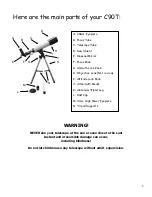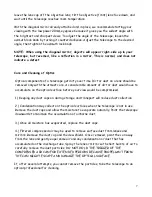
8
If you keep the dust caps on your telescope when it is not in use and avoid handling the
lenses or mirrors, only minimal optical maintenance of your telescope should be required.
Extensive cleaning is usually only necessary every few years.
What to Look For in the Sky
There is a whole universe of objects you could view at night, so where do you start? We
recommend starting with the most prominent objects first.
The moon
The moon is the easiest target to find at night. When the moon is in full position, it
bathes the night with a silvery light that washes the sky of all but the brightest
objects. The best time to view the moon is not when it is full, but rather when it is less
than half full. The dividing line between dark and light on the moon, called the
terminator, shows the best detail in the craters and mountains.
The planets
The planets, our solar system companions, range in size from moon-size rocky bodies to
giant gas balls, which could hold Earth 1000 times over. To find the planets, you will
need information about their times of visibility. An astronomy magazine will give you the
locations of the planets, as they change position from month to month. The Internet is
also an excellent source of information, starcharts, maps, and more! The popular and
more familiar constellations often provide the easiest landmarks to help find the
planet’s locations and paths of orbit. Most people have looked up at night and seen some
of the planets without even realizing it. A planet appears like a bright star but does not
twinkle like a star; it will look like a tiny ball. Venus, Mars, Jupiter, and Saturn, are the
easiest planets to view. Mercury is dimmer, usually below the horizon, and is more
challenging to find.
Each of the planets provides interesting views. Venus is covered with clouds so all that
is visible is an extremely bright light, the brightest next to the moon. Venus, like the
moon, goes through phases, however. As it travels around the sun, different areas of
the planet’s surface are illuminated, producing crescent shapes of varying size. Mars is
the red planet. When it is above the horizon, it is noticeably red and stands out like a
beacon in the night sky. The apparent brightness of Mars varies as the planet orbits
around the sun and throughout its period of visiblity, it will brighten and dim depending
on how near or far it is from Earth.




























